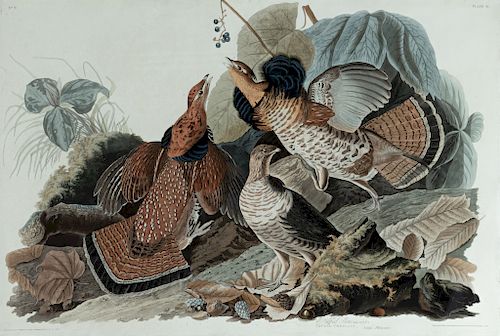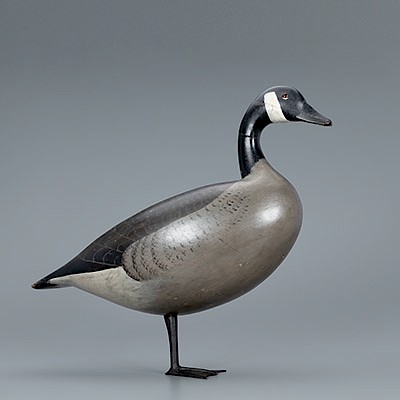John James Audubon (1785-1851)
Lot 62
About Seller
Copley Fine Art Auctions
20 Winter Street
Pembroke, MA 02359
United States
Founded in 2005, Copley Fine Art Auctions is a boutique auction house specializing in antique decoys and American, sporting, and wildlife paintings. Over the course of the last two decades, the firm has set auction records for not only individual decoy makers, but also entire carving regions. Copley...Read more
Estimate:
$50,000 - $60,000
Absentee vs Live bid
Two ways to bid:
- Leave a max absentee bid and the platform will bid on your behalf up to your maximum bid during the live auction.
- Bid live during the auction and your bids will be submitted real-time to the auctioneer.
Bid Increments
| Price | Bid Increment |
|---|---|
| $0 | $50 |
| $1,000 | $100 |
| $2,500 | $250 |
| $5,000 | $500 |
| $10,000 | $1,000 |
| $25,000 | $2,500 |
| $50,000 | $5,000 |
About Auction
By Copley Fine Art Auctions
Feb 16, 2019
Set Reminder
2019-02-16 10:00:00
2019-02-16 10:00:00
America/New_York
Bidsquare
Bidsquare : The Winter Sale 2019
https://www.bidsquare.com/auctions/copley/the-winter-sale-2019-3820
The sale will offer the opportunity to view and take home world-class paintings and fine bird carvings. Featuring selections from the collections of Alfred Ely, L. H. LaMonte, Grant Nelson, Ronald S. Swanson, Herb Wetanson, and a descendant of Chester F. Spear among others. Copley Fine Art Auctions cinnie@copleyart.com
The sale will offer the opportunity to view and take home world-class paintings and fine bird carvings. Featuring selections from the collections of Alfred Ely, L. H. LaMonte, Grant Nelson, Ronald S. Swanson, Herb Wetanson, and a descendant of Chester F. Spear among others. Copley Fine Art Auctions cinnie@copleyart.com
- Lot Description
John James Audubon (1785-1851)
Ruffed Grous[e] (No. 9, Plate 41), 1828 hand-colored engraving and aquatint, sheet size 25 1/2 by 38 1/2 in. "Drawn from Nature & Published by J.J. Audubon F.R.S.E. F.L.S. M.W.S." lower left "Engraved by R. Havell. Jun. Printed & Coloured by R. Havell. Sen. London. 1828" lower right on J. Whatman Turkey Mill watermarked paper
Audubon writes extensively about the habits and habitats of the Ruffed Grouse, “Although these birds are particularly attached to the craggy sides of mountains and hills, and the rocky borders of rivers and small streams, thickly mantled with evergreen trees and small shrubs of the same nature, they at times remove to low lands, and even enter the thickest cane-brakes, where they also sometimes breed.”
“The shooting of Grouse of this species is precarious, and at times very difficult, on account of the nature of the places which they usually prefer. Should, for instance, a covey of these birds be raised from amongst Laurels (Kalmia latifolia) or the largest species of Bay (Rhododendron maximum), these shrubs so intercept the view of them, that, unless the sportsman proves quite an adept in the difficult art of pulling the trigger of his gun at the proper moment, and quickly, his first chance is lost, and the next is very uncertain.”
“When our mountains are covered with a profusion of huckleberries and whortleberries, about the beginning of September, then is the time for shooting this species, and enjoying the delicious food which it affords.”
Audubon puts forth close observations of their behavior, reporting “The flight of the Ruffed Grouse is straight-forward, rather low, unless when the bird has been disturbed, and seldom protracted beyond a few hundred yards at a time…I have said this much respecting the flight of Grouse, because it is a prevalent opinion, both among sportsmen and naturalists, that the whirring sound produced by birds of that genus, is a necessary effect of their usual mode of flight. But that this is an error, I have abundantly satisfied myself by numberless observations.”
“The Ruffed Grouse, on alighting upon a tree, after being raised from the ground, perches amongst the thickest parts of the foliage, and, assuming at once an erect attitude, stands perfectly still, and remains silent until all appearance of danger has vanished. If discovered when thus perched, it is very easily shot.”
Audubon was so enamored of the sporting value of the Ruffed Grouse that he proposed introducing it to the United Kingdom, saying, “The size of these birds, the beauty of their plumage, the excellence of their flesh, and their peculiar mode of flying, would render them valuable, and add greatly to the interest of the already diversified sports of that country.”
Provenance: Private Collection, Pennsylvania
Literature: John James Audubon, “Ruffed Grouse,” Audubon Society, accessed December 11, 2018, https://www. audubon.org/birds-of-america/ruffed-grouseCondition report requests can be made via email or by telephone (info@copleyart.com or 617.536.0030). Any condition statement given is a courtesy to customers, Copley will not be held responsible for any errors or omissions. The absence of a condition statement does not imply that the lot is in perfect condition.Condition
- Shipping Info
-
Shipping info
Copley Fine Art Auctions does not handle the shipping of any items. Shipping is the sole responsibility of the buyer. Once your payment has cleared, and we have received your authorized shipping release form items may be released for shipment. Copley Fine Art Auctions, LLC shall have no liability for any loss or damage to such items. Buyers should allow up to four weeks for shipment.Please be aware that internet bidders may NOT not pick up their items at the sale. Items will be available for pick up by appointment or by shippers five days after the sale.
-



 EUR
EUR CAD
CAD AUD
AUD GBP
GBP MXN
MXN HKD
HKD CNY
CNY MYR
MYR SEK
SEK SGD
SGD CHF
CHF THB
THB












